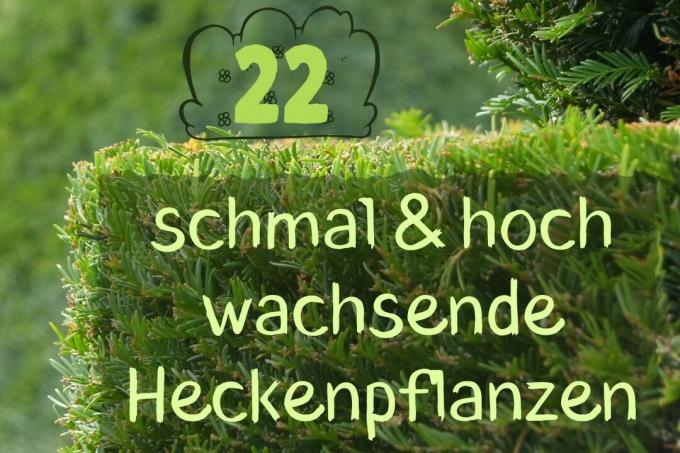
table of contents
- Deciduous hedge plants
- Types from A - R
- Types from S - Z
- Evergreen hedge plants
- Types from A - R
- Types from S - Z
- frequently asked Questions
Not every garden has enough space for a lush hedge. So that you can plant a privacy screen in spite of the lack of space, we present 23 hedge plants that grow tall and narrow.
In a nutshell
- large selection of hedge plants for sun and shade
- deciduous as well as evergreen species
- Flower hedges are particularly attractive
- high cut tolerance ensures growth limitation
- Variegated foliage varieties are often more sun-hungry and more sensitive to the cold
Deciduous hedge plants
Types from A - R
Green barberry (Berberis thunbergii)

The undemanding one Barberry is an excellent hedge plant that also adorns itself with magical flowers in May. In autumn the fresh green leaves turn deep red.
- Location: sunny to partially shaded
- Growth: upright, many shoots
- Growth height: up to 250 centimeters
- Spread: 60 to 220 centimeters
- Growth rate: 20 to 35 centimeters per year
Japanese column cherry 'Amanogawa' (Prunus serrulata 'Amanogawa')

In April, the Japanese inspires Column cherry with a fragrant, pink sea of flowers, which provides valuable food for bees and other insects.
- Location: sunny to partially shaded
- Growth: columnar
- Height: up to five meters
- Spread: 100 to 150 centimeters
- Growth rate: 20 to 50 centimeters per year
Oval-leaved liguster (Ligustrum ovalifolium)
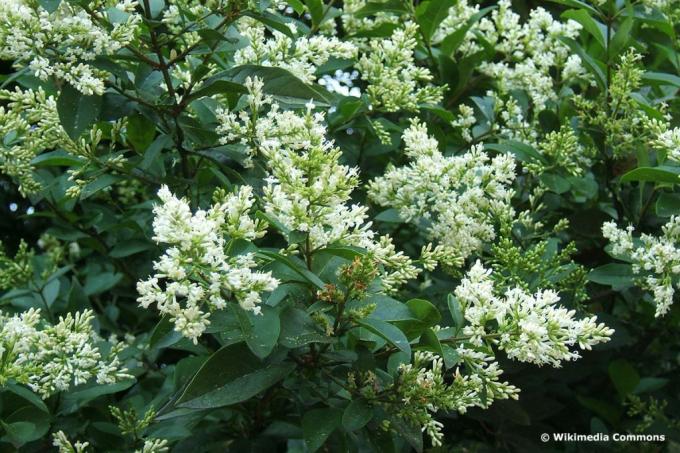
This uncomplicated type of privet grows quite high and stays green through the winter when the weather is good.
- Location: sunny to shady
- Growth: upright, shrub-like
- Height: up to five meters
- Spread: 150 to 300 centimeters
- Growth rate: 15 to 30 centimeters per year
Pyramidal hornbeam (Carpinus betulus 'Fastigiata')

Hornbeams or hornbeams are the right choice for planting beech hedges.
- Location: sunny to shady
- Growth: columnar to pyramidal
- Height: free-standing up to 20 meters
- Spread: four to five meters
- Growth rate: 10 to 30 centimeters per year
Red barberry 'Atropurpurea' (Berberis thunbergii 'Atropurpurea')
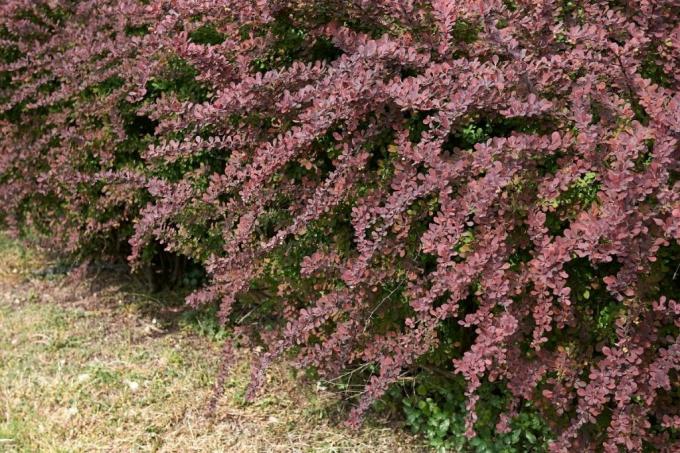
This very dense hedge plant not only shows beautiful, dark red foliage, but is also very robust and adaptable.
- Location: sunny to partially shaded
- Habit: upright, slightly overhanging
- Height: up to three meters
- Spread: up to two meters
- Growth rate: 20 to 40 centimeters per year
Tip: Barberries are valuable for bee nourishment and provide birds with protective hiding places for breeding.
Types from S - Z
Pillar rock pear 'Obelisk' (Amelanchier alnifolia 'Obelisk')

Rock pears like this variety, which even has edible fruits, are just right for a loose hedge made from native wild bushes.
- Location: sunny to partially shaded
- Growth: stiffly upright, columnar
- Height: up to five meters
- Spread: 100 to 175 centimeters
- Growth rate: 20 to 40 centimeters per year
Column hornbeam 'Monument' (Carpinus betulus 'Fastigiata Monument')

This hornbeam species grows particularly compact and dense, and is also undemanding in terms of its location.
- Location: sunny to shady
- Growth: compact, stocky, densely branched
- Height: up to six meters
- Spread: 100 to 150 centimeters
- Growth rate: 30 to 40 centimeters per year
Note: Between April and May the hornbeam shows numerous yellowish-green, woolly catkins.
Column hawthorn (Crataegus monogyna 'Stricta')

This variety of the native hawthorn grows very narrowly in contrast to the original species. The flowering time in May attracts numerous insects, and the native wild shrub offers birds protection.
- Location: sunny to shady
- Growth: columnar, dense
- Height: up to six meters
- Spread: two to three meters
- Growth rate: 20 to 25 centimeters per year
Black-green privet 'Atrovirens' (Ligustrum vulgare 'Atrovirens')

Privet is an ideal hedge plant because it is very easy to cut and robust. The plant tolerates both sun and full shade and is very undemanding.
- Location: sunny to shady
- Growth: stiffly upright
- Height: up to four meters
- Spread: up to four meters
- Growth rate: 40 to 100 centimeters per year
Shrub maple 'Phoenix' (Acer conspicuum 'Phoenix')
The shrubby-growing maple species with the bright red bark is very easy to cut and therefore well suited for a hedge planting.
- Location: sunny to partially shaded
- Habit: shrubby, upright
- Height: up to four meters
- Spread: 100 to 200 centimeters
- Growth rate: 20 to 40 centimeters per year
Ornamental currant (Ribes sanguineum 'Pulborough Scarlet')
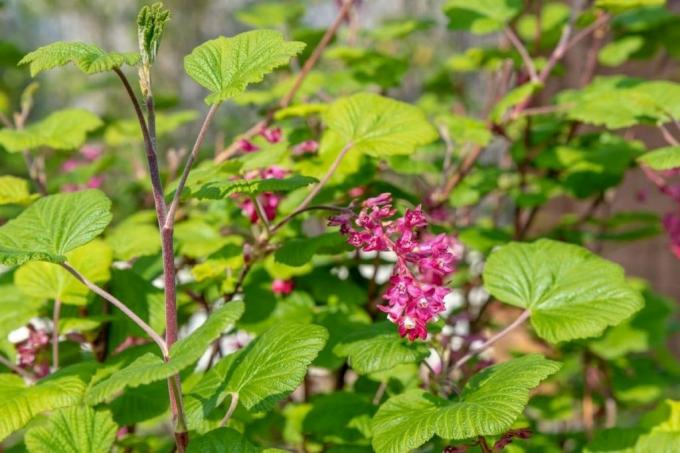
Ornamental currants are strong and fast-growing hedge plants that bloom profusely from April to May.
- Location: sunny to partially shaded
- Growth: shrubby
- Growth height: up to 250 centimeters
- Spread: 100 to 200 centimeters
- Growth rate: 15 to 30 centimeters per year
Evergreen hedge plants
Types from A - R
Blue cypress (Chamaecyparis lawsoniana 'Glauca')

This hedge plant convinces with its bluish, very dense needles that shine beautifully in the sun.
- Location: sunny to shady
- Growth: columnar, closed, opaque in the early stages
- Height: up to ten meters
- Spread: 100 to 200 centimeters
- Growth rate: 5 to 20 centimeters per year
Fruiting cup grater (Taxus media 'Hicksii')

This yew variety is ideal for every hedge that needs to be tall and narrow. It feels good on fresh to moist soil.
- Location: sunny to partially shaded
- Habit: columnar to broadly upright
- Height: up to five meters
- Spread: two to four meters
- Growth rate: 10 to 15 centimeters per year
Note: This yew develops a lot of red fruits, which are, however, poisonous and therefore not suitable for consumption.
Yellow pillar (Taxus baccata 'Fastigiata Aureomarginata')

The variety, also known as the gold columnar yew, has all the advantages of the local yew tree, but delights with its unusual golden-yellow to greenish-yellow needles.
- Location: sunny to shady
- Growth: narrow, upright
- Height: up to five meters
- Spread: 100 to 250 centimeters
- Growth rate: 5 to 10 centimeters per year
Note: Like all yew trees, this variety with all parts of the plant - bark, leaves, shoots and fruits - is highly toxic.
Tree of Life 'Columna' (Thuja occidentalis 'Columna')

This dense and bushy growing tree of life is one of the most popular hedge plants.
- Location: sunny to partially shaded
- Growth: narrow, aspiring
- Height: up to eight meters
- Spread: 80 to 150 centimeters
- Growth rate: 15 to 20 centimeters per year
Tree of Life ‚Smaragd '(Thuja occidentalis‚ Smaragd')

The easy-care thuja 'Smaragd' scores with its dense growth and fresh green needle-like dress.
- Location: sunny to partially shaded
- Growth: narrowly conical
- Height: up to six meters
- Spread: 70 to 180 centimeters
- Growth rate: 10 to 30 centimeters per year
Types from S - Z
Columnar (Taxus baccata 'Fastigiata')
This yew tree remains columnar even in old age, is very robust and grows densely.
- Location: sunny to shady
- Growth: columnar
- Height: up to eight meters
- Spread: 150 to 200 centimeters
- Growth rate: 20 to 25 centimeters per year
Column cypress (Chamaecyparis lawsoniana 'Columnaris')
This columnar growing cypress is one of the most popular hedge plants. It forms a dense screen made of bluish needles.
- Location: sunny to shady
- Growth: compact, upright
- Height: up to six meters
- Spread: 100 to 175 centimeters
- Growth rate: 15 to 20 centimeters per year
Column cypress (Chamaecyparis lawsoniana 'Ellwoodii')
The column cypress is uncomplicated, undemanding and also tolerates urban climates and problematic weather. It grows very densely.
- Location: sunny to shady, tolerates a lot of shade
- Growth: columnar to conical
- Height: up to four meters
- Spread: 60 to 150 centimeters
- Growth rate: 5 to 20 centimeters per year
Narrow pillar (Taxus baccata 'Fastigiata Robusta')
This variety of the native yew scores with robustness, undemanding and a very dense growth.
- Location: sunny to partially shaded
- Growth: cigar-shaped
- Height: up to eight meters
- Spread: 100 to 150 centimeters
- Growth rate: 20 to 40 centimeters per year
Swedish columnar juniper (Juniperus communis 'Suecica')
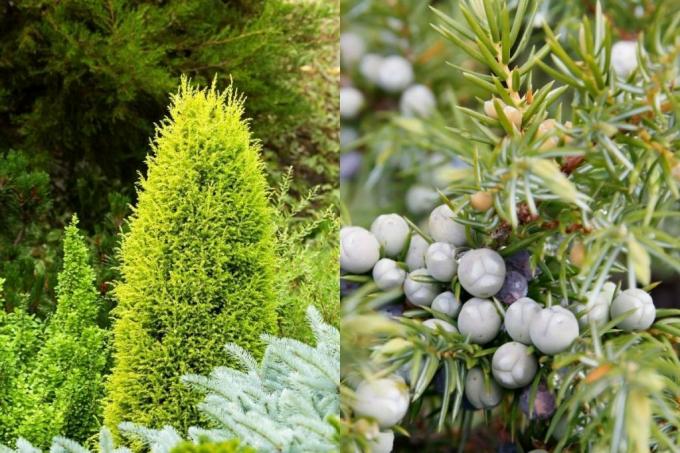
This is a narrow and tall growing variety of the native juniper that scores with its blue-green leaf color.
- Location: sunny
- Habit: shrub to columnar, often multi-stemmed
- Height: up to four meters
- Spread: 100 to 150 centimeters
- Growth rate: 15 to 20 centimeters per year
Rocket junior 'Skyrocket' (Juniperus scopulorum 'Skyrocket')

This juniper is also good for urban climates and is insensitive to emissions. In addition, its needles have a beautiful blue-gray color.
- Location: sunny
- Growth: stiffly upright with vertically striving branches
- Height: up to seven meters
- Spread: 150 to 200 centimeters
- Growth rate: 15 to 20 centimeters per year
frequently asked Questions
If there is not enough space for a hedge, you can also set up a wire mesh and let it overgrown with climbing plants. Ivy, for example, is very suitable for this, but also wild wine, Black-eyed Susan, The American pipe bindweed, Chinese split flask (Schisandra), trumpet bindweed, funnel bindweed or the honeysuckle can be used for this purpose. This allows you to create a privacy screen that grows high quickly and remains particularly narrow.
If there is still enough space in front of the hedge, you can use it for planting ferns, grasses, ground cover or flowering perennials. This creates a smooth transition from the high hedge to the rest of the garden space. When choosing plants, however, make sure that they can cope with a partially shaded or even shady location, as well as with root pressure.
Another good alternative if the hedge is to be tall and narrow is a living wicker fence. To do this, too, first of all set up a wire mesh at the desired height and then move it into Regularly stick freshly cut willow twigs into the ground and cut the twigs through the mesh to braid. As soon as the branches have taken root, they begin to turn green.
